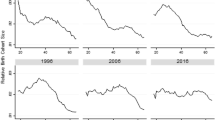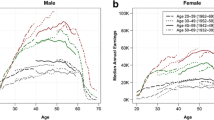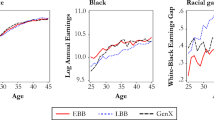Abstract
This paper uses longitudinal data to estimate cohort changes in the earnings trajectories of young adult males. Levels of earnings are uniformly lower for male workers turning 21 between 1980 and 1991 than in 1970-1979, although rates of earnings growth are roughly comparable. Among males turning 21 before 1980, six in 10 (60%) of all men and seven in 10 (71%) college-educated men attained earnings levels by age 30 that were at least twice the poverty level. Corresponding fractions for workers turning 21 between 1980 and 1991 were considerably lower (42% and 56%). Recent cohorts from all demographic subgroups appeared to have more difficulty than older cohorts in attaining middle-class earnings.
Similar content being viewed by others
References
Boisjoly, J., G. Duncan, and T. Smeeding. 1995. “The Shifting Incidence of lnvoluntary Job Losses from 1968 to 1992.” Mimeographed document, Center for Urban Affairs and Policy Research, Northwestern University.
Borjas, G., R. Freeman, and L. Katz. 1990. “On the Labor Market Effects of Immigration and Trade.” Unpublished manuscript.
Bound, 1., C. Brown, G. Duncan, and W. Rodgers. 1994. “Evidence on the Validity of Cross-Sectional and Longitudinal Labor Market Data.” Journal of Labor Economics 12:345–68.
Bound, J., G. Duncan, D. Laren, and L. Oleinick. 1991. “Poverty Dynamics in Widowhood.” Journal of Gerontology: Social Sciences 46(3):115–24.
Bound, J. and H. Holtzer. 1991. "Industrial Shifts, Skill Levels, and the Labor Market for White and Black Males." Mimeographed document, Population Studies Center, Ann Arbor.
Bound, J. and G. Johnson. 1991. “Changes in the Structure of Wages in the 1980s: An Evaluation of Alternative Explanations.” American Economic Review 82:371–92.
Bound, J. and A. Krueger. 1991. “The Extent of Measurement Error in Longitudinal Earnings Data: Do Two Wrongs Make a Right?” Journal of Labor Economics 9(1):1–21.
Diebolt, F., D. Neumark, and D. Polsky. 1994. “Job Stability in the United States.” Working Paper 4859, National Bureau of Economic Research, Cambridge, MA.
Duncan, G., T. Smeeding, and W. Rodgers. 1993. “W(h)ither the Middle Class? A Dynamic View.” Pp. 240–71 in Poverty and Prosperity in the USA in the Late Twentieth Century, edited by D. Papadimitriou and E. Wolff. London: Macmillan.
Farber, H. 1993. “The Incidence and Costs of Job Loss: 1982-91.” Brookings Papers on Economic Activity: Microeconomics 1:73132.
Freeman, R. 1987. “Crime and the Employment of Disadvantaged Youth.” Working Paper 3875, National Bureau of Economic Research, Cambridge, MA.
Gottschalk, P. and R. Moffitt. 1992. “Earnings and Wage Distributions in the NLS, CPS, and PSID.” Part I of final report to the U.S. Department of Labor, Brown University.
Gottschalk, P. and R. Moffitt 1994. “The Growth of Earnings Instability in the U.S. Labor Market.” Brookings Papers on Economic Activity:217-54.
Gottschalk, P. and T. Smeeding. 1995. “Cross-National Comparisons of Levels and Trends in Inequality.” Mimeographed document, Boston College and Syracuse University.
Grusky, D. and T. DiPrete. 1990. “Recent Trends in the Process of Stratification.” Demography 27:617–37.
Hauser, R., J. Warren, M. Huang, and W. Carter. 1995. “Occupational Status; Education and Social Mobility in the Meritocracy. Mimeographed document, Department of Sociology, University of Wisconsin.
Holden, K. and T. Smeeding. 1990. “The Poor, the Rich and the Insecure Elderly Caught In-Between.” Milbank Quarterly 68:191–219.
Hotz, J., L. Xu, M. Tienda, and A. Ahituv. 1995. “The Returns to Early Work Experience in the Transition from School to Work for Young Men in the U.S.: An Analysis of the 1980s.” Mimeographed document, University of Chicago.
Karoly, L. 1993. “Trends in Inequality among Families, Individuals and Workers in the United States: A Twenty-Five Year Perspective.” Pp. 19–98 in Uneven Tides: Rising Inequality in America, edited by S. Danziger and P. Gottschalk. New York: Russell Sage.
Katz, L. and K. Murphy. 1992. “Changes in Relative Wages, 19631987: Supply and Demand Factors.” Quarterly Journal of Economics 107(1):35–78.
Levy, F. and R. Murnane. 1992. “U.S. Earnings Levels and Earnings Inequality: A Review of Recent Trends and Proposed Explanations.” Journal of Economic Literature 30:1333–81.
Lillard, L. and R. Willis. 1978. “Dynamic Aspects of Earnings Mobility.” Econometrica 46:985–1012.
Little, R. and H. Suo 1989. “Item Nonresponse in Panel Surveys.” Pp. 400–25 in Panel Surveys, edited by D. Kaspryzk, G. Duncan, G. Kalton, and M. Singh. New York: Wiley.
Loprest, P. 1992. “Gender Differences in Wage Growth and Job Mobility.” American Economic Review 82:526–32.
Mincer,1. 1974. Schooling, Experience and Earnings. New York: National Bureau of Economic Research.
Moffitt, R. and P. Gottschalk. 1993. “Trends in the Covariance Structure of Earnings in the United States: 1969-1987.” Discussion Paper 1001–93, Institute for Research on Poverty, Madison, WI. Newman, K. 1988. Falling from Grace. New York: Vintage.
— 1993. Declining Fortunes: The Withering of the American Dream. New York: Basic Books.
Panel on Poverty and Family Assistance. 1995. Measuring Poverty: A New Approach. Washington, DC: National Academy Press.
Ruggles, P. 1990. Drawing the Line. Washington, DC: Urban Insti-tute Press.
Scholtz, J. and A. Maritato. 1990. “Dimensions of Vulnerability Facing Young Families.” Mimeographed document, Institute for Research on Poverty, Madison, WI.
Swinnerton, K. and H. Wial. 1995. “Is Job Stability Declining in the U.S. Economy?” Industrial and Labor Relations Review 48:293–304.
Topel, R. and M. Ward. 1992. “Job Mobility and the Careers of Young Men.” Quarterly Journal of Economics 107:439–80.
U.S. Bureau of the Census. 1992. “Workers with Low Earnings: 1964 to 1990.” Current Population Reports, Series P-60, No. 179. Washington, DC: U.S. Department of Commerce.
Welch, F. 1979. “Effects of Cohort Size on Earnings: The Baby Boom Babies’ Financial Bust.” Journal of Political Economy 87(5, part 2):565–97.
Wilson, W. 1987. The Truly Disadvantaged: The Inner City, The Underclass and Public Policy. Chicago: University of Chicago Press.
Author information
Authors and Affiliations
Corresponding author
Additional information
We are grateful to the Sloan Foundation and to the Center for Advanced Studies in the Behavioral Sciences under NSF Grant SBR-9022192 for supporting this research.
Rights and permissions
About this article
Cite this article
Duncan, G.J., Boisjoly, J. & Smeeding, T. Economic mobility of young workers in the 1970s and 1980s. Demography 33, 497–509 (1996). https://doi.org/10.2307/2061783
Issue Date:
DOI: https://doi.org/10.2307/2061783




